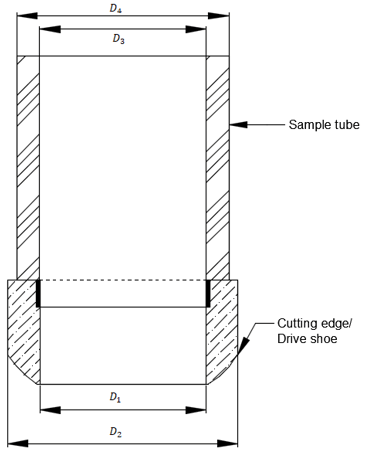This set of Foundation Engineering Multiple Choice Questions & Answers (MCQs) focuses on “Soil Samples and Samplers – 1”.
1. The depth of exploration for isolated spread footing is ___________
a) 1\(\frac{1}{2}\) the width
b) 2\(\frac{1}{2}\) the width
c) \(\frac{1}{2}\) the width
d) \(\frac{1}{4}\) the width
View Answer
Explanation: The depth of exploration for isolated spread footing is one and a half times the width. While the depth of exploration is twice the height from stream bed to crest for concrete dams.
2. In hand operated rings in ‘auger and shell boring’ the depth of which it can be used is _________
a) 40 m
b) 30 m
c) 25 m
d) 15 m
View Answer
Explanation: The hand operated rings in ‘auger and shell boring’ are used for depths up to 25 m and the mechanised rings up to 50 m. In auger boring, hand augers are used for depths up to about 6 m.
3. Auger is suitable for _______
a) soft to stiff clays
b) very stiff clays
c) sandy soils
d) hard clays
View Answer
Explanation: Auger boring is suitable for soft to stiff clays as the soil samples can be removed in a less disturbed manner preserving most of the natural structure of sample as compared to the wash boring.
4. In rotator boring __________ is forced down the hallow drillrods.
a) glycerine
b) water solution of bentonite
c) dextrin
d) phenyl
View Answer
Explanation: In rotator boring, a drilling mud, usually a water solution of bentonite with or without other admixtures is continuously forced down the hollow drilling rods. The mud returning upwards bring the cuttings to the surface.
5. A ________ sample has preserved natural structure of soil.
a) undisturbed
b) disturbed
c) non-representative
d) remoulded
View Answer
Explanation: The undisturbed sample of the soil is the one which has the natural structure in a preserved state which may be obtained by freezing the sand up to the required depth.
6. ________ sample has the natural structure of soil as modified.
a) undisturbed
b) disturbed
c) representative
d) non-remoulded
View Answer
Explanation: The disturbed sample of the soil has the natural structure of soil as modified due to the disturbance caused while collecting the soil sample. It is usually obtained by pump and shells with trap valve.
7. The area ratio of the sampler is __________

a) \(\frac{D_2^2-D_1^2}{D_1^2}×100\)
b) \(\frac{D_1^2-D_2^2}{D_1^2}×100\)
c) \(\frac{D_2^3+D_1^3}{D_1^2}×100\)
d) \(\frac{D_2^2-D_1^2}{2D_1^2}×100\)
View Answer
Explanation: The area ratio of the soil sampler is defined as the ratio of the volume of the soil sample displaced by the sampler tube in proportion to the volume of sample.
∴ Area ratio=\(\frac{D_2^2-D_1^2}{D_1^2}×100.\)
8. The inside clearance of the sampler is ________

a) \(\frac{D_3-D_1}{D_1} ×100 \)
b) \(\frac{D_3+D_1}{D_1} ×100\)
c) \(\frac{D_3-D_1}{D_3} \)
d) \(\frac{D_3-D_1}{2D_1} ×100\)
View Answer
Explanation: The inside clearance of the sampler is defined as the difference between the outside diameter and the inside diameter of the core part through which the core enters.
∴ Inside clearance = \(\frac{D_3-D_1}{D_1} ×100. \)
9. The outside clearance of the sampler is ______

a) \(\frac{D_3-D_1}{D_1} ×100 \)
b) \(\frac{D_3+D_1}{D_1} ×100 \)
c) \(\frac{D_2-D_4}{D_4} ×100 \)
d) \(\frac{D_2+D_4}{D_4} ×100 \)
View Answer
Explanation: Outside clearance is the gap between the outer surface of the cutting edge and the outside surface of the sam¬pling tube. Outside clearance prevents frictional drag between the outside surface of the sampling tube and the walls of the borehole.
10. In the open drive samples, the tube head is provided with vents.
a) True
b) False
View Answer
Explanation: In the open drive samples, the tube head is provided with vents. The vents or valves are provided so as to permit water and air to escape during driving. The check valve helps to retain sample when the sampler is raised.
11. In open drive samples, the tube is split into two parts.
a) True
b) False
View Answer
Explanation: In open drive samples, the tube can be split into two parts. This type of sampler is known as the split-spoon sampler. The split tube may also contain an inside thin wall liner.
12. The depth up to which the increase in pressure due to structural loading is likely to cause perceptible settlement is _______
a) insignificant depth
b) significant depth
c) trifling depth
d) nugatory
View Answer
Explanation: The depth of exploration is carried to a depth up to which the increase in pressure due to structural loading is likely to cause perceptible settlement or shear failure. This depth is known as significant depth.
13. The significant depth is assumed up to a level at which the net increase in vertical pressure becomes _______ of initial overburden pressure.
a) 10% to 20%
b) less than 10%
c) 20% to 30%
d) 50% to 70%
View Answer
Explanation: The significant depth is assumed up to a level at which the net increase in vertical pressure becomes less than 10% of initial overburden pressure. Also a pressure bulb bounded by an isobar of 1/5 or 1/10 of the surface loading intensity is assumed as minimum depth of exploration.
Sanfoundry Global Education & Learning Series – Foundation Engineering.
To practice all areas of Foundation Engineering, here is complete set of 1000+ Multiple Choice Questions and Answers.
If you find a mistake in question / option / answer, kindly take a screenshot and email to [email protected]
- Practice Geotechnical Engineering I MCQs
- Check Geotechnical Engineering II Books
- Practice Civil Engineering MCQs
- Apply for Civil Engineering Internship
- Check Civil Engineering Books
